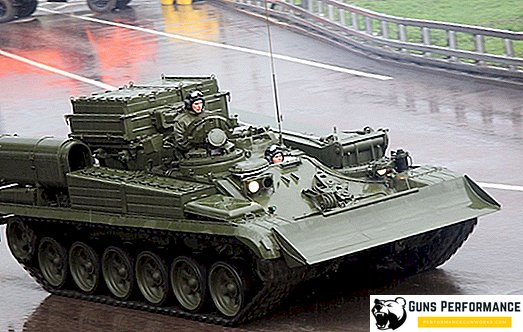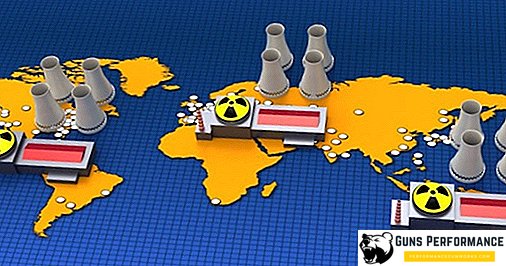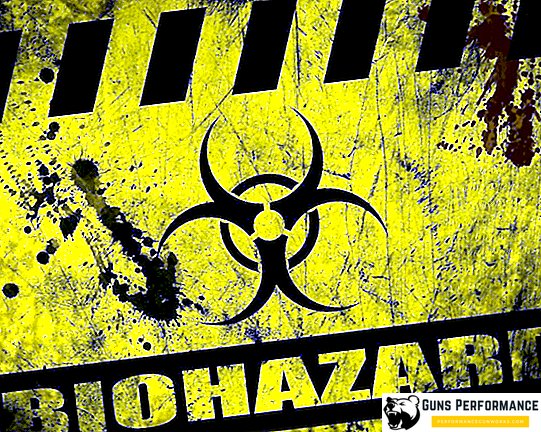
A biological or bacteriological weapon is a type of weapon of mass destruction (WMD), which uses various pathogens to destroy an enemy. The main purpose of its use is the mass destruction of enemy personnel, in order to achieve this, provoking epidemics of dangerous diseases among its troops and civilians.
The term "bacteriological weapon" is not entirely true, since not only bacteria, but also viruses and other microorganisms, as well as toxic products of their vital activity, are used to defeat the enemy. In addition, the composition of biological weapons include the means of delivery of pathogens to the place of their use.
Sometimes an entomological weapon is distinguished as a separate species, which uses insects to attack the enemy.
Modern war is a whole complex of actions aimed at the destruction of the enemy's economy. Biological weapons fit perfectly into its concept. After all, it is possible to infect not only the enemy's soldiers or his peaceful population, but also the destruction of agricultural crops.
Biological weapons are the oldest type of weapons of mass destruction, people tried to use it in ancient times. It was not always effective, but sometimes led to impressive consequences.
Currently, biological weapons are outlawed: a number of conventions banning their development, storage and use have been adopted. However, despite all international conventions, information about new developments of these prohibited weapons regularly appears in the press.
Many experts believe that bacteriological weapons are even more dangerous than nuclear ones. Its properties and features are such that they may well lead to the complete destruction of the human race on the planet. Despite modern advances in medicine and biology, it’s not yet possible to talk about the victory of humanity over disease. We cannot cope with HIV infection and hepatitis, and even banal flu leads to regular epidemics. The action of biological weapons is not selective. A virus or pathogenic bacterium does not discern where its and a stranger, and when they are released, they destroy all living things in their path.

History of biological weapons
Mankind has repeatedly faced with devastating epidemics and led a huge number of wars. Often, both of these disasters went hand in hand. Therefore, it is not surprising that many military leaders came up with ideas about the use of infections as weapons.
It should be noted that a high level of morbidity and mortality was commonplace for the armies of the past. Huge human clusters, vague ideas about sanitation and hygiene, poor nutrition - all this created excellent conditions for the development of infectious diseases in the army. Very often, soldiers died of diseases much more than the actions of the enemy army.
Therefore, the first attempts to use infections to defeat the enemy troops were made several thousand years ago. The Hittites, for example, simply sent people suffering from tularemia to the enemy camp. In the Middle Ages, new ways of delivering biological weapons were invented: the corpses of people and animals who died from some fatal disease were thrown into the besieged cities with the help of catapults.
The most terrible result of the use of biological weapons in antiquity is the epidemic of bubonic plague in Europe, which broke out in the XIV century. During the siege of the city of Kafa (modern Theodosius), the Tatar Khan Janibek threw the corpses of people who died of the plague behind the walls. An epidemic began in the city. Part of the townspeople fled from her on a ship to Venice, and in the end they brought the infection there.

Soon the plague literally wiped out Europe. Some countries have lost up to half the population, the victims of the epidemic numbered in the millions.
In the 18th century, the European colonialists supplied the North American Indians with blankets and tents, which were used by patients with smallpox. Historians are still arguing over whether it was intentionally done. Be that as it may, the epidemic that broke out as a result practically destroyed many native tribes.
Scientific progress gave humanity not only vaccination and antibiotics, but also the possibility of using the most deadly pathogens as a weapon.
The process of rapid development of biological weapons began relatively recently - around the end of the XIX century. The Germans during the First World War unsuccessfully tried to cause an epizootic of anthrax in the enemy troops. During World War II, Japan created a special secret unit - Detachment 731, which conducted work in the field of biological weapons, including experiments on prisoners of war.
During the war, the Japanese infected China’s population with bubonic plague, resulting in the death of 400,000 Chinese. The Germans actively and fairly successfully distributed malaria in the territory of modern Italy, and about 100 thousand Allied soldiers died from it.
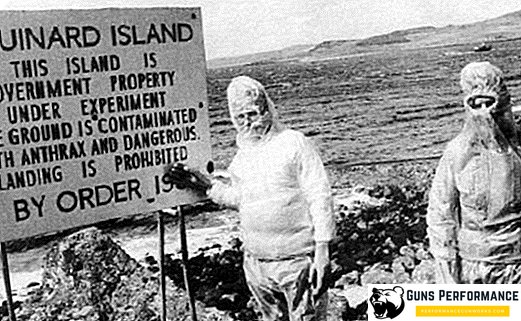
After the end of the Second World War, these weapons of mass destruction were no longer used, at least the signs of its large-scale use were not recorded. There is information that the Americans used biological weapons during the war in Korea - but it was not possible to confirm this fact.
In 1979, an anthrax epidemic broke out on the territory of the USSR in Sverdlovsk. It was officially announced that the cause of the outbreak of the disease is the eating of meat from infected animals. Modern researchers have no doubt that the real reason for the destruction of the population by this dangerous infection was an accident at a secret Soviet laboratory, where they developed biological weapons. In a short period, 79 cases of infection were recorded, 68 of which have been fatal. This is a clear example of the effectiveness of biological weapons: as a result of accidental infection, the death rate was 86%.
Features of biological weapons
Benefits:
- High efficiency of application;
- The difficulty of timely detection by the enemy of the use of biological weapons;
- The presence of a latent (incubation) period of infection makes the fact of using this MLE even less noticeable;
- A wide variety of biological agents that can be used to defeat an adversary;
- Many types of biological weapons are capable of epidemic spread, that is, the defeat of the enemy, in fact, becomes a self-sustaining process;
- The flexibility of this weapon of mass destruction: there are diseases that temporarily make a person incompetent, while other ailments are fatal;
- Microorganisms are able to penetrate into any premises, engineering structures and military equipment also does not guarantee protection against contamination;
- The ability of biological weapons to infect humans, animals, and agricultural plants. Moreover, this ability is very selective: some pathogens cause human diseases, others infect only animals;
- Biological weapons have a strong psychological impact on the population, panic and fear spread instantly.
It should also be noted that biological weapons are very cheap; it is not difficult to create them, even for a state with a low level of technical development.
However, this type of weapons of mass destruction has a significant drawback, which limits the use of biological weapons: it is extremely indiscriminate.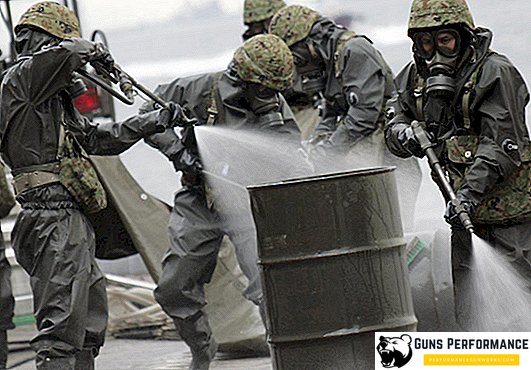
After applying a pathogenic virus or anthrax bacillus, you cannot guarantee that the infection will not empty your country. Science is not yet able to provide guaranteed protection against microorganisms. Moreover, even a pre-established antidote may not be effective, because viruses and bacteria constantly mutate.
That is why in the recent history of biological weapons almost never used. Probably, this trend will continue in the future.
Classification of biological weapons
The main difference between different types of biological weapons is the pathogen used to defeat the enemy. It is he who determines the basic properties and characteristics of the WMD. The causative agents of various diseases can be used: plague, smallpox, anthrax, Ebola, cholera, tularemia, tropical fever, and botulinum toxins.
Various means and methods can be used to spread infections:
- artillery shells and mines;
- special containers (bags, bags or boxes) scattered from the air;
- aerial bombs;
- devices that disperse aerosols with the causative agent of infection from the air;
- contaminated household items (clothing, shoes, food).
Separately, it should be allocated entomological weapons. This is a type of biological weapon in which insects are used to attack the enemy. At different times, bees, scorpions, fleas, Colorado beetles and mosquitoes were used for these purposes. The most promising are mosquitoes, fleas and some species of flies. All these insects can carry various diseases of humans and animals. At various times there were programs for the cultivation of agricultural pests to damage the economy of the enemy.
WMD Protection
All methods of protection against biological weapons can be divided into two large groups:
- prophylactic;
- emergency

Preventive control methods consist in vaccination of military personnel, civilians, farm animals. The second direction of prevention is the creation of a whole complex of mechanisms that allow detecting infection as quickly as possible.
Emergency methods of protection against biological threats include various methods of treating diseases, preventive measures in emergency cases, isolation of the source of infection, and disinfection of the area.
During the Cold War, repeated exercises were conducted to eliminate the consequences of the use of biological weapons. Other modeling methods were used. As a result, it was concluded that the state with a normally developed medicine is able to cope with any known types of similar weapons of mass destruction.
However, there is one problem: modern work on the creation of new types of fighting microorganisms based on the methods of biotechnology and genetic engineering. That is, developers create new strains of viruses and bacteria with unprecedented properties. If such a pathogen breaks free, it can lead to the beginning of a global epidemic (pandemic).
Recently, rumors about the so-called genetic weapons have not abated. Usually, it means genetically modified pathogenic microorganisms that are capable of selectively infecting people of a certain nationality, race or gender. However, most scientists are quite skeptical about the idea of such weapons, although experiments in this direction were carried out accurately.
Biological Weapons Convention
There are several conventions prohibiting the development and use of biological weapons. The first of them (the Geneva Protocol) was adopted in 1925 and expressly prohibited to engage in such work. Another similar convention appeared in Geneva in 1972, as of January 2012, it was ratified by 165 states.






